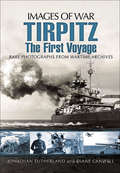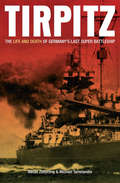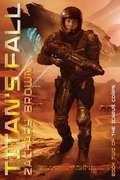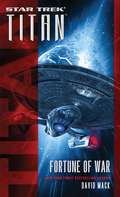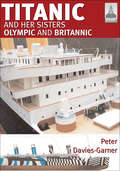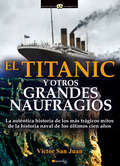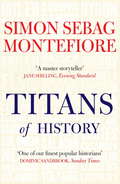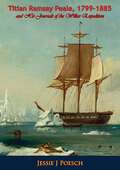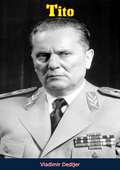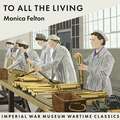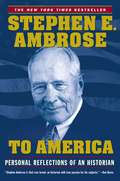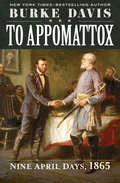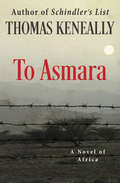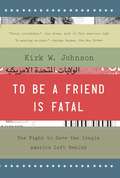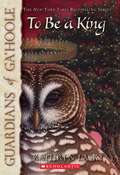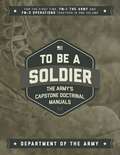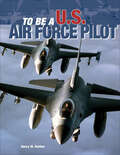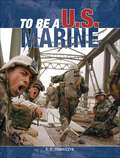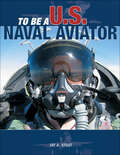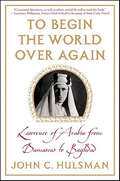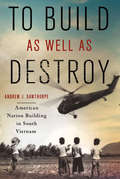- Table View
- List View
Tirpitz: The First Voyage (Images Of War Ser.)
by Diane Canwell Jonathan SutherlandThe photos in this book are taken from an unpublished album belonged to a member of the crew of famous German Battleship Tirpitz. It is a little known fact that before the start of World War Two the ship went on a shakedown voyage into the Atlantic, traveling north into Arctic waters and south into the more tropical climbs of the Caribbean. There are superb photos of the officers and crew both above and below decks, including some unique shots of the crew during their stint on a magnificent sail training vessel. Other stunning shots show the vessels mighty weapons during gunnery practice during her sea trials. This unique collection gives a close up view of one of the most powerful ships of World War Two, a ship that proved to be a persistent thorn in the side of the Royal Navy until sunk in Norway towards the end of the war.\
Tirpitz: The Life and Death of Germany's Last Super Battleship
by Niklas Zetterling Michael TamelanderThe authors of Bismarck deliver &“a very good account of the Tirpitz and of the naval war in the North Atlantic and Norwegian waters&” during World War II (NYMAS Review). After the Royal Navy&’s bloody high seas campaign to kill the mighty Bismarck, the Allies were left with an uncomfortable truth—the German behemoth had a twin sister. Slightly larger than her sibling, the Tirpitz was equally capable of destroying any other battleship afloat, as well as wreaking havoc on Allied troop and supply convoys. For the next three and a half years, the Allies launched a variety of attacks to remove Germany&’s last serious surface threat, hidden within fjords along the Norwegian coast. Trying an indirect approach, the British launched one of the war&’s most daring commando raids—at St. Nazaire—in order to knock out the last drydock in Europe capable of servicing the Tirpitz. Of over six hundred commandos and sailors in the raid, more than half were lost during an all-night battle that succeeded, at least, in knocking out the drydock. It was not until November 1944 that the Tirpitz finally succumbed to British aircraft armed with ten-thousand–pound Tallboy bombs, the ship capsizing at last with the loss of one thousand sailors. In this book, military historians Niklas Zetterling and Michael Tamelander, authors of Bismarck: The Final Days of Germany&’s Greatest Battleship, illuminate the strategic implications and dramatic battles surrounding the Tirpitz, a ship that may have had greater influence on the course of World War II than her more famous sister. &“A riveting story . . . keeps the reader engaged.&” —Nautilus, A Maritime Journal of Literature, History and Culture
Titan #6: Synthesis (Star Trek: The Next Generation #No. 6)
by James SwallowThe Starship Titan continues on her outward voyage of discovery. Ranging farther and farther from Federation space, Captain William Riker and the crew look forward to living Starfleet's mission: seeking out new life, discovering new civilizations.Striking a "sandbank" -- a spatial distortion -- the Titan is knocked out of warp, her crew shaken up but uninjured. Titan has stumbled across a battlefield, and floating in it, shattered and in pieces, are the remains of a ship. Searching for survivors, they discover the ship never had a crew. The away team removes the computer core, looking for answers. Once the device is restored, it becomes clear this is not just a computer, but a thinking, reasoning artificial intelligence. It identifies itself as SecondGen White-Blue, and it comes from a civilization composed entirely of sentient computers. Eons ago these artificial intelligences were charged to be the first line of defense against The Null -- a destructive force so all-consuming that generation upon generation have waged unending war trying to find a way to beat back this terror. Captain Riker offers to assist them, but years of war have left the AIs distrustful and suspicious, especially of organics. The tide of the battle is turning, and The Null is winning. Set free, it will destroy everything in this system and then, unchecked, spread its mindless destruction into the heart of the Federation.
Titan's Fall: The Darkside War; Titan's Fall; Jupiter Rising (The Icarus Corps #2)
by Zachary BrownIn book two of the fast-paced Icarus Corps series, the Colonial Protection Forces wages war on the Conglomeration making a stand on Titan—and this battle may be the final one.The rapacious alien forces have taken their war to our solar system. Now that the human and PAC forces won a decisive battle on the moon, they need to try to head off the coming armada before their overpowering strength is amassed and The Icarus Corps is once again on the front line. But are they there just for fodder? And what exactly are they fighting for: Continued subjugation within the PAC or Earth first? Book two in The Icarus Corps, Titan’s Fall continues the team’s adventures as they wards off a fierce race of alien conquerors as they fight for humanity’s place at the vanguard of of this galactic war.
Titan: Fortune of War (Star Trek)
by David MackAn original spin-off novel set in the popular Star Trek: The Next Generation universe from New York Times bestselling author David Mack.Death slumbers in the ashes of silent planets, waiting to be awakened and unleashed… Twenty years have passed since the interstellar scourge known as the Husnock were exterminated without warning by a being with godlike abilities. Left behind, intact but abandoned, their desolate worlds and derelict ships brim with destructive potential. Now a discovery by a Federation cultural research team has drawn the attention of several ruthless factions. From black market smugglers to alien military forces, it seems every belligerent power in the quadrant hopes to capture the Husnock's lethal technology. All that stands between the galaxy and those who have come to plunder the cruelest secrets of the Husnock are Admiral William Riker, Captain Christine Vale, and the crew of the Starship Titan. ™, ®, & © 2017 CBS Studios, Inc. STAR TREK and related marks and logos are trademarks of CBS Studios, Inc. All Rights Reserved.
Titanic and Her Sisters Olympic and Britannic: And Her Sisters Olympic And Britannic (ShipCraft #18)
by Peter Davies-GarnerThe ShipCraft series explores the iconic pleasure vessels Titanic, Olympic, and Britannic in fully illustrated detail for building your own model ship. In the first of the ShipCraft series to cover non-naval vessels, this meticulously researched and illustrated volume looks at the legendary cruise ship RMS Titanic and her sisters, Olympic and Britannic. Written for the serious model ship builder, this book not only covers the many model kits available, but a concise history of the ship&’s class, including every detail that contributed to the ship&’s creation. Accompanied by hundreds of photographs of models in various scales, the text covers paint colors, line drawings, and scale plans, as well as the differences in the ships&’ appearance over time. An invaluable resource on available models, their pros and cons, and ways to modify and customize each one, this ShipCraft title concludes with a reference section essential to any modeler.
Titanic y otros desastres navales (Historia Incógnita)
by Víctor San JuanLa auténtica historia de los más trágicos mitos de la historia naval de los últimos cien años. Titanic, Príncipe de Asturias, Lusitania, Andrea Doria,… Colosales catástrofes, secretos ocultados por los gobiernos, los más estremecedores desastres navales de los últimos cien años. Asómbrese con las grandes tragedias del mar del último siglo, siniestros, accidentes o pérdidas de grandes buques mercantes, militares y de pasajeros que provocaron enormes pérdidas humanas y desastres ecológicos como resultado de imprudencias humanas o fallos técnicos. La docena de casos más célebres de accidentes navales del siglo XX, descritos y analizados en esta obra divulgativa de rigurosa investigación. Las causas, cómo se produjeron los siniestros y sus consecuencias. Pocos sucesos atrajeron la atención, impresionaron o estremecieron el ánimo de varias generaciones tanto como el siniestro del Titanic, donde perdieron la vida más de mil quinientas personas, el desafortunado fin del Lusitania, el Andrea Doria o el escalofriante naufragio del Príncipe de Asturias.
Titans of History
by Simon Sebag MontefioreIn The Titans of History, Simon Sebag Montefiore brings together a vivid and compelling selection of the lives of the towering figures that, for better of for worse, have changed the course of history. The 14th-century Mongol warlord Tamerlane, who once ordered the building of a pyramid of 70,000 human skulls from those that his army had beheaded, rubs shoulders with Oskar Schindler, the man whose selfless heroism saved over 1,000 Jews from death at the hands of the Nazis. In between these two extremes are those extraordinary figures, like Henry VIII, in whom good and evil were mixed promiscuously.Inspiring and horrifying in equal measure, in The Titans of History, Simon Sebag Montefiore has created an engaging, innovative and authoritative window into the history of the world.
Titian Ramsay Peale, 1799-1885, and His Journals of the Wilkes Expedition
by Jessie J PoeschTitian was a son of renowned portrait artist and museum founder Charles Wilson Peale from Philadelphia. Titian was an artist, naturalist and explorer, who accompanied the Wilkes Exploratory Expedition of the American Northwest in 1838-1842. He collected and studied shells, birds, plants and animals.
Tito (World Affairs Ser.)
by Vladimir DedijerTHE STORY, TOLD LARGELY BY HIMSELF, OF MARSHAL TITO OF YUGOSLAVIA—THE MAN WHOM STALIN MOST HATES AND FEARSTHE FIRST BIG HOLE in the iron curtain was cut in 1948 by Marshal Tito and the Yugoslavian people when they walked out of the Cominform, defying Stalin, the Red Army, and Moscow’s secret police. This was the first rebellion of a Soviet satellite state. It is not likely to be the last.Here is the only authentic inside story of this decisive moment in modern history, told in the context of Tito’s life, with about forty per cent of the text in Tito’s own words, recorded by one of his closest friends. Here is the story of Tito’s personal relations with Stalin, how the leaders of the Communist world would drink and talk and joke with each other, how Stalin felt about the Communists in Greece and China, the true stories of Dimitrov, Gomulka, Anna Pauker and the fierce struggle for power which goes on among the rulers of the Communist world. No other man has seen this world on the top level and survived to tell it.It is told here in the exciting story of the life of an itinerant machinist who wandered around Europe, Russia and the revolutionary movement until Hitler’s attack on his country in 1941 threw him into leadership of the Yugoslav Partisan Army.
Tito, Mihailovic, and the Allies
by Walter R. RobertsThis new edition contains a new foreword by the author.
To All The Living: Imperial War Museum Wartime Classics
by Monica FeltonIn January 1941 Griselda Green arrives at Blimpton, a place 'so far from anywhere as to be, for all practical purposes, nowhere.'Monica Felton's 1945 novel gives a lively account of the experiences of a group of men and women working in a munitions factory during the Second World War. Wide-ranging in the themes it touches on, including class, sexism, socialism, fear of communism, workers' rights, anti-semitism, and xenophobia, the novel gives a vivid portrayal of factory life and details the challenges, triumphs and tragedies of a diverse list of characters. Adding another crucial female voice to the Wartime Classics series, To All the Living provides a fascinating insight into a vital aspect of Britain's home front. Praise for Imperial War Museum Wartime Classics: 'If poetry was the supreme literary form of the First World War then, as if in riposte, in the Second World War, the English novel came of age. This wonderful series is an exemplary reminder of that fact. Great novels were written about the Second World War and we should not forget them.' WILLIAM BOYD'It's wonderful to see these books given a new lease of life [...] classic novels from the Second World War written by those who were there, experienced the fear, anguish, pain and excitement first-hand and whose writings really do shine an incredibly vivid light onto what it was like to live and fight through that terrible conflict.' JAMES HOLLAND, Historian, author and TV presenter'The Imperial War Museum has performed a valuable public service by reissuing these absolutely superb novels.' ANDREW ROBERTS, author of Churchill: Walking with Destiny(P)2021 Headline Publishing Group Limited
To America: Personal Reflections of an Historian
by Stephen E. AmbroseIn To America, Stephen E. Ambrose, one of the country's most influential historians, reflects on his long career as an American historian and explains what an historian's job is all about. He celebrates America's spirit, which has carried us so far. He confronts its failures and struggles. As always in his much acclaimed work, Ambrose brings alive the men and women, famous and not, who have peopled our history and made the United States a model for the world. Taking a few swings at today's political correctness, as well as his own early biases, Ambrose grapples with the country's historic sins of racism, its neglect and ill treatment of Native Americans, and its tragic errors (such as the war in Vietnam, which he ardently opposed on campus, where he was a professor). He reflects on some of the country's early founders who were progressive thinkers while living a contradiction as slaveholders, great men such as Washington and Jefferson. He contemplates the genius of Andrew Jackson's defeat of a vastly superior British force with a ragtag army in the War of 1812. He describes the grueling journey that Lewis and Clark made to open up the country, and the building of the railroad that joined it and produced great riches for a few barons. Ambrose explains the misunderstood presidency of Ulysses S. Grant, records the country's assumption of world power under the leadership of Theodore Roosevelt, and extols its heroic victory of World War II. He writes about women's rights and civil rights and immigration, founding museums, and nation- building. He contrasts the presidencies of Dwight Eisenhower, John F. Kennedy, Richard Nixon, and Lyndon B. Johnson. Throughout, Ambrose celebrates the unflappable American spirit. Most important, Ambrose writes about writing history. "The last five letters of the word 'history' tell us that it is an account of the past that is about people and what they did, which is what makes it the most fascinating of subjects." To America is an instant classic for all those interested in history, patriotism, and the love of writing.
To Appomattox: Nine April Days, 1865
by Burke DavisA gripping account of the last nine days of the Civil War from the New York Times–bestselling author of Sherman&’s March. After four long years of fighting, the Army of Northern Virginia was irreparably broken in April 1865, despite the military brilliance of its commander, Gen. Robert E. Lee. Acclaimed author Burke Davis recounts the last days leading up to Lee&’s surrender to Union army commander Ulysses S. Grant in this riveting and uniquely revealing journey down the final road to Appomattox Court House. Beginning his remarkable saga during the decisive Siege of Petersburg, Davis chronicles the last days of the War between the States in intimate and unforgettable detail. Drawing on a wide array of voices—from frontline soldiers and battlefield commanders to presidents Abraham Lincoln and Jefferson Davis to regular citizens in the North and the South—To Appomattox vividly captures the human stories behind one of the most enthralling chapters in American history.
To Asmara: A Novel of Africa
by Thomas KeneallyA disillusioned reporter joins three fellow Westerners on a journey of discovery through the raging fires of a brutal East African conflict With his own life in flux, Timothy Darcy, an Australian journalist, finds escape in the ongoing turmoil of Eritrea. Entering the war-torn East African region with three Western strangers on missions of their own--Christine, a young Frenchwoman searching for her lost cinematographer father; Lady Julia, an aging British feminist; and Mark Henry, an American aid worker whose motives are masked in shadow--Darcy is plunged into the center of a twenty-five-year-long conflict between Ethiopian Emperor Haile Selassie's army and Eritrean guerillas. Witnessing scenes of brutality, starvation, and oppression as they venture ever deeper into the true heart of darkness, the dispassionate reporter and his companions will never be the same. Based on his own firsthand experiences in Africa, Thomas Keneally, the acclaimed Man Booker Prize-winning author of Schindler's List, delivers a powerful and profoundly moving novel of war, injustice, commitment, courage, and self-discovery set amid the horrors and tragedy of the vicious Eritrean conflict.
To Be a Friend Is Fatal: The Fight to Save the Iraqis America Left Behind
by Kirk W JohnsonIn January 2005 Kirk Johnson, then twenty-four, arrived in Baghdad as USAID's only Arabic-speaking American employee. Despite his opposition to the war, Johnson felt called to civic duty and wanted to help rebuild Iraq. Appointed as USAID's first reconstruction coordinator in Fallujah, he traversed the city's IED-strewn streets, working alongside idealistic Iraqi translators--young men and women sick of Saddam, filled with Hollywood slang, and enchanted by the idea of a peaceful, democratic Iraq. It was not to be. As sectarian violence escalated, Iraqis employed by the US coalition found themselves subject to a campaign of kidnapping, torture, and assassination. On his first brief vacation, Johnson, swept into what doctors later described as a "fugue state," crawled onto the ledge outside his hotel window and plunged off. He would spend the next year in an abyss of depression, surgery, and PTSD--crushed by having failed in Iraq. One day, Johnson received an email from an Iraqi friend, Yaghdan: "People are trying to kill me and I need your help. " After being identified by a militiaman, Yaghdan had emerged from his house to find the severed head of a dog and a death threat. That email launched Johnson's now seven-year mission to get help from the US government for Yaghdan and thousands of abandoned Iraqis like him. The List Project has helped more than 1,500 Iraqis find refuge in America. "To Be a Friend Is Fatal" is Kirk W. Johnson's unforgettable portrait of the human rubble of war and his efforts to redeem a shameful chapter of American history.
To Be a Friend Is Fatal: The Fight to Save the Iraqis America Left Behind
by Kirk W. JohnsonThe stunning memoir of "one of the few genuine heroes of America's war in Iraq" (Dexter Filkins), a rare glimpse into the perspective of the Iraqi people, and a searching exploration of America's moral obligations to those Iraqis who stepped forward to help.In January 2005 Kirk Johnson, then twenty-four, arrived in Baghdad as USAID's only Arabic-speaking American employee. Despite his opposition to the war, Johnson felt called to civic duty and wanted to help rebuild Iraq. Appointed as USAID's first reconstruction coordinator in Fallujah, he traversed the city's IED-strewn streets, working alongside idealistic Iraqi translators--young men and women sick of Saddam, filled with Hollywood slang, and enchanted by the idea of a peaceful, democratic Iraq. It was not to be. As sectarian violence escalated, Iraqis employed by the US coalition found themselves subject to a campaign of kidnapping, torture, and assassination. On his first brief vacation, Johnson, swept into what doctors later described as a "fugue state," crawled onto the ledge outside his hotel window and plunged off. He would spend the next year in an abyss of depression, surgery, and PTSD--crushed by having failed in Iraq. One day, Johnson received an email from an Iraqi friend, Yaghdan: People are trying to kill me and I need your help. After being identified by a militiaman, Yaghdan had emerged from his house to find the severed head of a dog and a death threat. That email launched Johnson's now seven-year mission to get help from the US government for Yaghdan and thousands of abandoned Iraqis like him. The List Project has helped more than 1,500 Iraqis find refuge in America. To Be a Friend Is Fatal is Kirk W. Johnson's unforgettable portrait of the human rubble of war and his efforts to redeem a shameful chapter of American history.
To Be a King (Guardians of Ga'Hoole #11)
by Kathryn LaskyHoole reclaims the throne of his father and goes on to wage a war against the forces of chaos, greed and oppression led by the powerful warlord-tyrants. Grank, the first collier, uses his skills with fire and metals to forge weapons for battle. With great trepidation Hoole uses the power of the Ember in the final, decisive battle and wins. At the dawn of a new ear of peace, Hoole searches for the ideal place to establish not a kingdom but an order of free owls and finds the Great Tree.
To Be a Soldier: The Army's Capstone Doctrinal Manuals
by Army, Department of theTo Be a Soldier offers the US Army’s two capstone doctrinal manuals in one place for the first time. This guide begins with the Army’s introductory text, FM-1 The Army, which explains the Army’s origin and purpose, its mission and values, how it functions as a portion of a joint military force in combat, and the importance of the individual soldier in a larger fighting force. When readers have learned the fundamentals of the Army, FM-3 Operations provides foundational knowledge of the full spectrum of Army operations. This manual is the Army’s principal tool for the instruction of today’s soldiers in the art and science of warfare, and has been recently updated to discuss counter-insurgency and hybrid threats in addition to conventional land operations. To Be a Soldier is the reader’s guide to the Army’s most fundamental knowledge by offering its two capstone texts in one place. The information in this handbook forms the basis for all the knowledge conveyed in any subsequent Army field manuals, making it required reading for all soldiers and readers with interest in US Army training and operations.
To Be a U.S. Air Force Pilot (To Be A)
by Henry M. HoldenA comprehensive look into what it takes to make a pilot in the United States Air Force.To Be a U.S. Air Force Pilot details every step of training for those with the skill and daring to “cross into the blue” as an elite US Air Force pilot. The book traces the growth of aspiring young recruits, starting with grueling physical and mental tests, early flight training on high-tech flight simulators, moving onward and upward until they are finally ready to push the outer envelope to Mach II in state-of-the-art fighter aircraft.Thanks to the highly motivated, highly skilled, and dedicated men and women of the United States Air Force, America enters the uncertain landscape of the twenty-first century with the most powerful, swift, and flexible military force the world has ever seen.
To Be a U.S. Marine (To Be A)
by S. F. TomajczykComprised of smart, highly adaptable men and women, the Marine Corps serves as the aggressive tip of the U.S. military spear. Theirs is a smaller, more dynamic force than any other in the American arsenal, and the only forward-deployed force designed for expeditionary operations by air, land, or sea. It is their size and expertise that allow them to move faster. Working to overcome disadvantage and turn conflict into victory, they accomplish great things, and they do so together. In the Marine Corps, there is a motto that describes their commitment to each other, their organization, and their country. It is Semper Fidelis or "Semper Fi." Translated from Latin, it means "Always Faithful."- Superb full-color action photos- Behind the scenes look at the training and structure- Next book in the colorful and successful series covering America's military forces- Still one of America's most combat efficient forcesFeatures:Chronological photographic displays, with personal stories, of a class of recruits as they progress through Marine recruit training.Steve Tomajczyk gains unprecedented access to the men in training around the country, including California, North Carolina, Virginia, and Okinawa.Superb full-color action photos.Author Steve Tomajczyk takes you through Marine recruit training - "Boot Camp" - the 13-week process that transforms a young person with the courage to succeed into a mature, highly disciplined, and fully capable Marine. During this time drill instructors teach individuals how to care for themselves and others, function as a member of a team and to achieve success together. Training includes first aid, water survival skills, marksmanship, tactics and other related topics. Training also focuses on customs, traditions and history that have made the Marine Corps respected around the world.About the AuthorS.F. Tomajczyk has written numerous books on weapons, agencies, and other aspects of the U.S. military and warfare, including Black Hawk, Bomb Squads, and Carrier Battle Group. Tomajczyk lives in Loudon, New Hampshire.
To Be a U.S. Naval Aviator (To Be A)
by Jay A. StoutFor anyone with the will to become a U.S. naval aviator, the future begins now. Marine fighter pilot and combat veteran Jay Stout shows us just what it takes to be a U.S. naval aviator in the twenty-first century, conducting us through every step of training as these dedicated, everyday heroes prepare for tomorrow’s threats while taking the fight to the enemy today. Throughout, Stout offers behind-the-scenes perspectives on the community of naval aviators, with profiles of the men and women who fly naval aircraft, of celebrated naval aviators, and of important figures in the history of naval aviation.
To Become a Bride (Bachelor Sisters Ser. #2)
by Carole MortimerFrom the first, Danie clashed swords with Jonas Noble, realizing that he was determined not to disclose the reasons for his dealings with her family.But Danie also found Jonas incredibly attractive, which made her plan to discover his motives all the harder to follow; the closer she got to Jonas, the more she fell in love! However, her heart was quietly breaking because of the secret she was hiding...a secret that would surely prevent what she really wanted: to become Jonas's bride...
To Begin the World Over Again: Lawrence of Arabia from Damascus to Baghdad
by John C. HulsmanThe little known history of Lawrence of Arabia's passionate and tragic advocacy of Arab nationalism during the pivotal years following WWI and his template for nation building in the Middle East.Lawrence of Arabia is best remembered for the Oscar-winning film about his life. But there is a different T.E. Lawrence, a man who applied his unique experiences and extensive knowledge of the Arab world to a political vision for nation building in the Middle East that holds many lessons for today. Following the Arab Revolt, Lawrence embarked on a heroic effort, harnessing his celebrity to force the British to keep the promises made to their Arab allies. Alas, he was unable to stop the Western powers from carving up the Middle East at Versailles, thus laying the foundations for the ongoing instability in that region. Still, until the day he died, Lawrence continued to fight for Arab nationalism, famously saying: "Better to let them do it imperfectly than do it perfectly yourself, for it is their country, their war, and your time is short." By weaving together a gripping narrative of Lawrence's Middle East adventures and highlighting his surprisingly astute political thinking, John Hulsman teases out this and many other lessons to be learned from Lawrence about the Arab world.
To Build as Well as Destroy: American Nation Building in South Vietnam
by Andrew J. GawthorpeFor years, the so-called better-war school of thought has argued that the United States built a legitimate and viable non-Communist state in South Vietnam in the latter years of the Vietnam War and that it was only the military abandonment of this state that brought down the Republic of Vietnam. But Andrew J. Gawthorpe, through a detailed and incisive analysis, shows that, in fact, the United States failed in its efforts at nation building and had not established a durable state in South Vietnam.Drawing on newly opened archival collections and previously unexamined oral histories with dozens of U.S. military officers and government officials, To Build as Well as Destroy demonstrates that the United States never came close to achieving victory in the late 1960s and early 1970s. Gawthorpe tells a story of policy aspirations and practical failures that stretches from Washington, D.C., to the Vietnamese villages in which the United States implemented its nationbuilding strategy through the Office of Civil Operations and Revolutionary Development Support known as CORDS. Structural factors that could not have been overcome by the further application of military power thwarted U.S. efforts to build a viable set of non-Communist political, economic, and social institutions in South Vietnam.To Build as Well as Destroy provides the most comprehensive account yet of the largest and best-resourced nation-building program in U.S. history. Gawthorpe's analysis helps contemporary policy makers, diplomats, and military officers understand the reasons for this failure. At a moment in time when American strategists are grappling with military and political challenges in Afghanistan, Iraq, and Syria, revisiting the historical lessons of Vietnam is a worthy endeavor.
